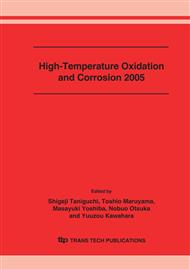p.555
p.563
p.571
p.581
p.589
p.595
p.603
p.609
p.617
Numerical Analysis and Control of Gas Carburizing under Changes in Gas Compositions
Abstract:
Low carbon steel, S15CK, was carburized at 1203K up to 12.93ks in a commercial furnace where RX gas converted from propane was employed as carrier gas. Gas compositions in the furnace were changed intentionally; consequently carbon potential changed from 0.8 to 1.2 mass%. The carbon content profiles were determined by a succession of grindings and carbon analyses of the ground surfaces with a vacuum type emission spectrometer. A mathematical model for calculation of carbon content profiles is proposed to describe carburizing behavior under time-variant gas compositions in a furnace. The calculated profiles were in good agreement with the experimental ones except the surface and its vicinity. This result indicates that the present model can be applied to gas carburizing in the furnace where gas compositions were changed.
Info:
Periodical:
Pages:
589-594
Citation:
Online since:
August 2006
Authors:
Price:
Сopyright:
© 2006 Trans Tech Publications Ltd. All Rights Reserved
Share:
Citation:


